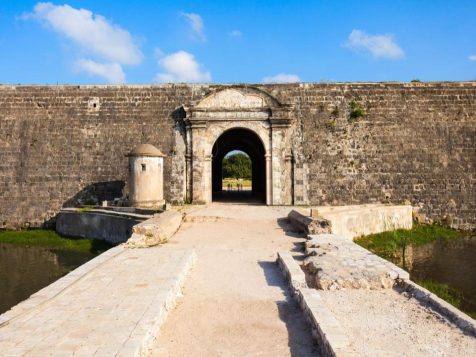The capital of the Northern Province of Sri Lanka and the main city in its eponymous district, Jaffna is also twelfth in the country in terms of absolute size. Its population amounts to 88,000 people in total. The distance from Colombo to Jaffna is 375 kilometers, a traveling time of at least seven hours via the A9 or Kandy-Jaffna Highway. Another popular method of traveling between the two cities is by the famous Yal Devi and the five other trains that commute passengers in and out of Jaffna. The Jaffna Railway was constructed curing British rule.
The original name of the place is “Yalpaanam”, or “Land of the Yazh-Player”, with the “yazh” or “yal” being old Tamil for the harp or a similar instrument. At times in history it has been called “Nagadipa” or “Naga Nadu”. This comes from the “Nagas”, an ethnically and genetically extinct culture from Northern Sri Lanka. The Portuguese colonists called it Jaffnapatao. The majority race here is Tamil and the main religions are Saivite Hinduism or Christianity. Historically though, there had been a thriving Buddhist population in Jaffna and even today there is a Buddhist minority in this part of the country. One of the best places to visit in Jaffna to see Buddhist relics is Kadurugoda or Kandarodai, a site that features small stupas encasing the relics of Tamil monks.
However prior to the 1980s, it was far larger, being second after Colombo.
Thanks to the strife in the region with the Sri Lankan Civil War, a large portion of its population has been expelled and consigned to refugee camps while others made it to the south. Even at present, the city bears many scars from the troubled times in recent history. It is much sparser than Colombo in terms of population. It is six miles away from Kandarodai, a site which has revealed that Jaffna has had an incredible history dating back to 2000 BC. The findings include coins known as puranas and point to the idea that Jaffna’s time in history had been eventful even before the supposed arrival of Indo-Aryan migrants.
While it is the capital of the north today, its suburb Nallur once held that distinction, with a small medieval kingdom centered on it. The Kingdom of Jaffna was a small provincial dominion, the home of the Brahman Arya Chakravarti Dynasty of Rameswaram. They opposed the incredible power of the southern kingdom of Kotte but were finally taken down by the Portuguese in 1619, despite them opposing Catholicism with added violence. From then on, Jaffna turned into a mere parcel to be passed among various colonial powers, from the Dutch to finally, the British while fulfilling its only purpose as just another port city. Presently Nallur itself is the cultural hub of Jaffna.
Some of the best places to visit in Jaffna include the famous Nallur Kandaswamy Kovil, among the most sacred Hindu sites in the island. It dates back to 1749, a recent construction but it is still viewed as a wonderful historical building.
The temple complex is dedicated to Lord Murugan, in the form of the trident or Vel. Originally it was an incredibly simple construction, with bricks and stone and a roof of coconut fronds. Later, the present shrine rooms and gopuram were added. At present, the gopuram is one hundred feet in height. It was only unveiled in 2011.
The Jaffna Fort was built by the Portuguese under Philip de Oliveira in 1618. It was taken by the Dutch and modified to suit their needs though in 1680, only to be captured by the British when they took over the north at last. During the recent war, the Sri Lankan army beseiged the fort which had been under enemy control. The maneuver was known as Operation Rivisera. The Queen’s House, Jaffna is a building inside the confines of the fort, used by both William Gopallawa and J.R. Jayawardena, both former presidents of Sri Lanka. It was first conceived as a governor’s residence.
There are many things to do in Jaffna that involve nature in some way. For example, island-hopping is a favorite activity among most tourists, with tours to the other islets around the Peninsula. These little landmasses include Kayts, Delft and many others. The wilderness here is dry and scrubby with some forests and marshland. Kayts is famous for having herds of feral horses that now roam the island quite freely. Also, there is the Jaffna Bird Sanctuary, which hosts numerous migrant waterfowl and other aquatic birds such as egrets and other members of the heron family. This sanctuary is set in a coastal marshland, one of the richest habitats in the area. There are also saltwater crocodiles here, the world’s largest reptiles. One of the most iconic landmarks here is the Jaffna Lagoon and walking along the shore at sunset or sunrise constitutes a wonderful thing to do in itself.
Written by Vasika Udurawane for Travel Lanka Compass



0 Comment